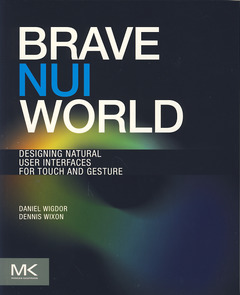Brave NUI World Designing Natural User Interfaces for Touch and Gesture
Auteurs : Wigdor Daniel, Wixon Dennis

Brave NUI World is the first practical guide for designing touch- and gesture-based user interfaces. Written by the team from Microsoft that developed the multi-touch, multi-user Surface® tabletop product, it introduces the reader to natural user interfaces (NUI). It gives readers the necessary tools and information to integrate touch and gesture practices into daily work, presenting scenarios, problem solving, metaphors, and techniques intended to avoid making mistakes.
This book considers diverse user needs and context, real world successes and failures, and the future of NUI. It presents thirty scenarios, giving practitioners a multitude of considerations for making informed design decisions and helping to ensure that missteps are never made again.
The book will be of value to game designers as well as practitioners, researchers, and students interested in learning about user experience design, user interface design, interaction design, software design, human computer interaction, human factors, information design, and information architecture.
Part I: Introduction
- Introduction
- The Natural User Interface
- Ecological Niche: Computing and the Social Environment & Ways of Working
- Less is More
- Contextual Environments
- Spatial
- Social
- Seamless
- Super Real
- Scaffolding
- User Differentiation
- The State-Model of Input Devices
- Fat Fingers
- No Touch Left Behind
- Touch vs. In-Air Gestures
- MDA Revisited
- New Primitives
- Anatomy of a Gesture
- Makes a good Gesture Language
- Self-Revealing Gestures
- Mode and Flow of a Gesture System
- Know your platform: Vision, Resistive, Capacitive, etc.
- The Fundamentals Have to Work
- Number of Contacts
- Contact Data: Shape, Pressure, and Hover
- Vertical/Horizontal/Mobile
- NUI UDI (User Defined Interface) and the Myth of the ‘Natural Gesture Set’.
- False Recognition
- RITE With a Purpose
- Conclusion: A word About Engineering
Part II: Design Ethos of NUI
Part III: New Technologies: Understanding & Technological Artefacts
Part IV: Creating an Interaction Language
Part V: No such thing as Touch
Part VI: Process: How do You Get There?
Part VII: Conclusion
Practitioners, researchers, students in user experience design, user interface design, interaction design, software design, human computer interaction, human factors, information design, information architecture, game designers
Dennis Wixon is currently Discipline Lead for Microsoft US BPD. Prior to this role he was the head of research for Microsoft Surface, and has also managed research teams at Microsoft Game Studies, and MSN/Home Products. Before joining Microsoft, Dennis managed the usability team at Digital Equipment Corporation, where a number of important usability methods such as Usability Engineering and Contextual Inquiry were developed. Dennis has been an active member of the user-research community for over 25 years. He co-chaired CHI 2002 served as Vice President for Conferences for ACM SIGCHI. Dennis has co-authored over sixty articles, book chapters and presentations on research methods and theory. He is an adjunct Full Professor in the Human Centered Design and Engineering Department at University of Washington and co-edited with Dr. Judy Ramey the book Field Methods Case Book for Software Design. Dennis holds a Ph.D. in Social Psychology from Clark University.
- Provides easy-to-apply design guidance for the unique challenge of creating touch- and gesture-based user interfaces
- Considers diverse user needs and context, real world successes and failures, and a look into the future of NUI
- Presents thirty scenarios, giving practitioners a multitude of considerations for making informed design decisions and helping to ensure that missteps are never made again
Date de parution : 04-2011
Ouvrage de 264 p.
19x23.3 cm
